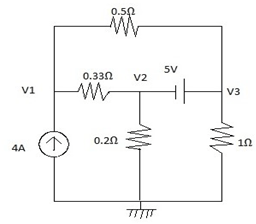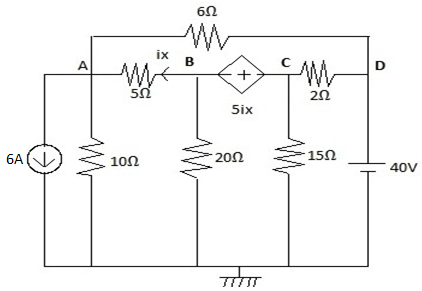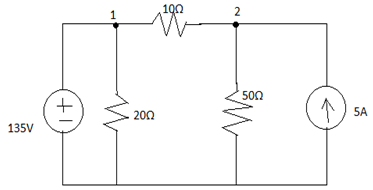This set of Electric Circuits Multiple Choice Questions & Answers (MCQs) focuses on “The Node-Voltage Method and Dependent Sources and Some Special Cases”.
1. Nodal analysis is mainly based on __________
a) KCL
b) KVL
c) Wheatstone bridge principle
d) Faraday’s electric laws
View Answer
Explanation: Nodal analysis or Node-Voltage method is done by identifying the currents at the node and thereby forming equations.
2. If there are n nodes, then how many node-voltage equations are required?
a) n
b) n+1
c) n-1
d) 1
View Answer
Explanation: If there are n nodes then n-1 nodal equations are required to describe the circuit.
3. Find VA and VB using Node-Voltage method in the given circuit.

a) 2.5V, 3.6V
b) 2.87V, 3.25V
c) 2.65V, 3.47V
d) 3.15V, 2.76V
View Answer
Explanation: Node A: VA/2 + (VA-1)/2 + (VA-VB)/1 =2
Node B: (VB-2)/2 + (VB-VA)/1 =1
By solving the above equations required voltages are obtained.
4. A supernode is between _____________
a) Essential node and reference node
b) Two reference nodes
c) Two essential nodes
d) Essential node and neutral path
View Answer
Explanation: A supernode is between two essential nodes.
5. Find V3 in the circuit given below.

a) 4.833V
b) 2.616V
c) -4.833V
d) -2.616V
View Answer
Explanation: supernode: V3-V2 = 5V
Node1: 166V1-100V2-66V3 =132
Node3: -166V1+265V2+99V3 =0
On solving the required voltage is obtained.
6. Find all the node voltages in the given circuit containing dependent sources.

a) 10V, 20V, 30V, 40V
b) 15V, 25V, 32V, 45V
c) 10V, -20V, 30V, -40V
d) -15V, 25V, -35V, 45V
View Answer
Explanation: At supernode: VC-VB=5iX
And ix = (VB-VA)/5. On solving remaining nodes and forming equations, the required voltage values at nodes are obtained.
7. What is the voltage at 2nd terminal in the given circuit?

a) 132.57V
b) 137.25V
c) 173.25V
d) 123.57V
View Answer
Explanation: Given voltage source 135V is in between essential node and reference node. So that implies V1 =135V. Using this, V2 can be calculated.
8. If there are 5 nodes then the no of nodal equations are ___________
a) 5
b) 0
c) 1
d) 4
View Answer
Explanation: If there are n nodes then n-1 nodal equations are required to describe the circuit.
9. If there are (N-2+3) Node-Voltage equations then the number of nodes in the circuit are __________
a) N+2
b) N+1
c) N
d) N-1
View Answer
Explanation: If there are n nodes then n-1 nodal equations are required to describe the circuit. So, given N-2+3 i.e. N+1 nodal equations and it implies N+2 nodes.
10. The reference node is also known as __________
a) Essential node
b) Principle node
c) Datum node
d) Neutral node
View Answer
Explanation: The node taken for reference in the network is known as reference node or datum node.
11. If there are 9 nodes, then how many node-voltage equations are required?
a) 9
b) 10
c) 8
d) 1
View Answer
Explanation: If there are n nodes then n-1 nodal equations are required to describe the circuit.
12. There are 13 branches in a complicated network and nearly 8 nodes. How many equations are required to solve the circuit in node-voltage method?
a) 7
b) 13
c) 5
d) 6
View Answer
Explanation: Branches number is not required in this method. Only nodes number is required.
Sanfoundry Global Education & Learning Series – Electric Circuits.
To practice all areas of Electric Circuits, here is complete set of 1000+ Multiple Choice Questions and Answers.
If you find a mistake in question / option / answer, kindly take a screenshot and email to [email protected]
- Check Electric Circuits Books
- Practice Electronics & Communication Engineering MCQs
- Practice Electrical Engineering MCQs
- Check Electrical Engineering Books
- Apply for Electrical Engineering Internship
